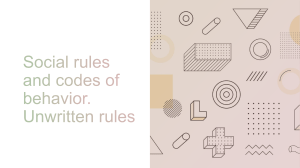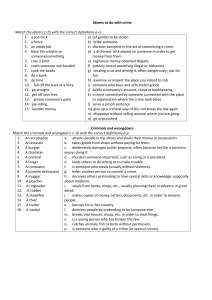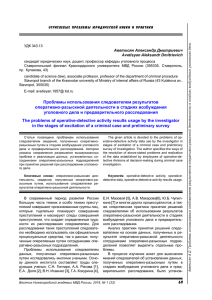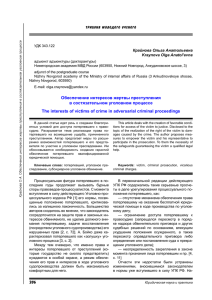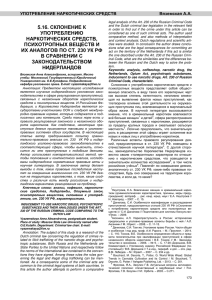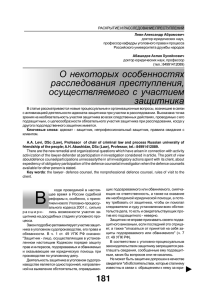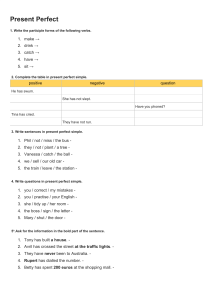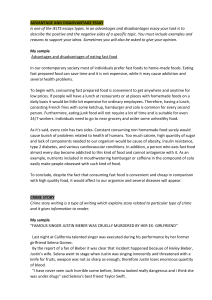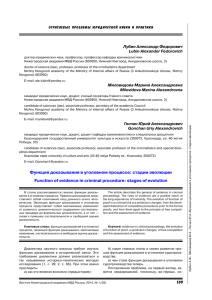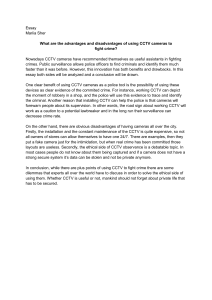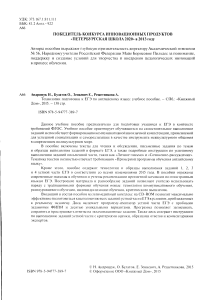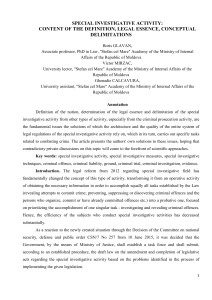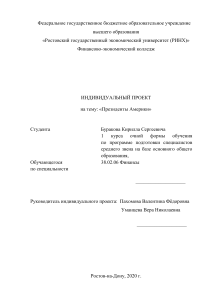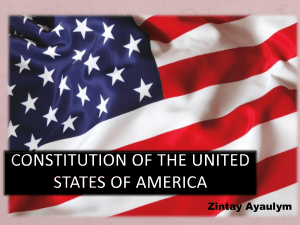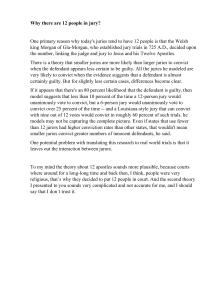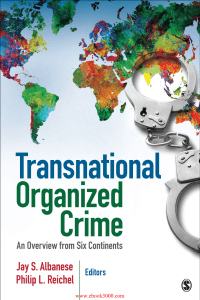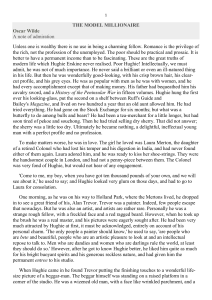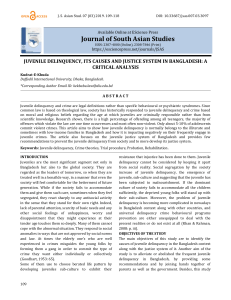Курс «Иностранный язык в Юриспруденции», сокращенные
advertisement
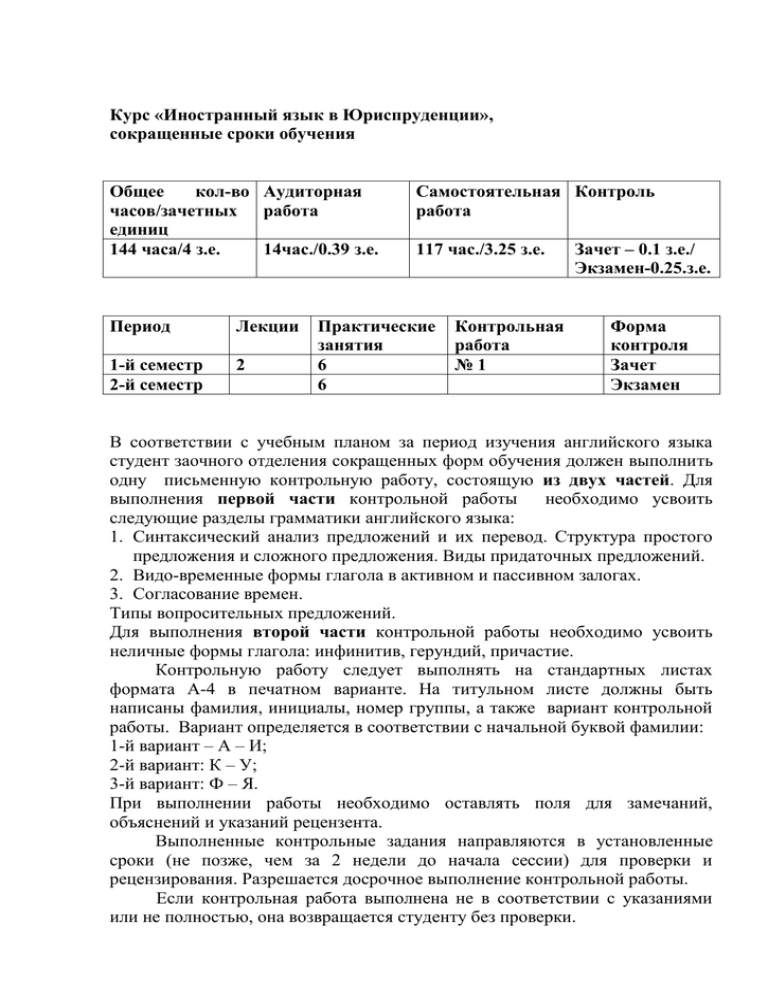
Курс «Иностранный язык в Юриспруденции», сокращенные сроки обучения Общее кол-во Аудиторная часов/зачетных работа единиц 144 часа/4 з.е. 14час./0.39 з.е. Период Лекции 1-й семестр 2-й семестр 2 Самостоятельная Контроль работа 117 час./3.25 з.е. Практические занятия 6 6 Контрольная работа №1 Зачет – 0.1 з.е./ Экзамен-0.25.з.е. Форма контроля Зачет Экзамен В соответствии с учебным планом за период изучения английского языка студент заочного отделения сокращенных форм обучения должен выполнить одну письменную контрольную работу, состоящую из двух частей. Для выполнения первой части контрольной работы необходимо усвоить следующие разделы грамматики английского языка: 1. Синтакcический анализ предложений и их перевод. Структура простого предложения и сложного предложения. Виды придаточных предложений. 2. Видо-временные формы глагола в активном и пассивном залогах. 3. Согласование времен. Типы вопросительных предложений. Для выполнения второй части контрольной работы необходимо усвоить неличные формы глагола: инфинитив, герундий, причастие. Контрольную работу следует выполнять на стандартных листах формата А-4 в печатном варианте. На титульном листе должны быть написаны фамилия, инициалы, номер группы, а также вариант контрольной работы. Вариант определяется в соответствии с начальной буквой фамилии: 1-й вариант – А – И; 2-й вариант: К – У; 3-й вариант: Ф – Я. При выполнении работы необходимо оставлять поля для замечаний, объяснений и указаний рецензента. Выполненные контрольные задания направляются в установленные сроки (не позже, чем за 2 недели до начала сессии) для проверки и рецензирования. Разрешается досрочное выполнение контрольной работы. Если контрольная работа выполнена не в соответствии с указаниями или не полностью, она возвращается студенту без проверки. По получении проверенной рецензентом контрольной работы следует внимательно прочитать рецензию, ознакомиться с замечаниями рецензента и проанализировать отмеченные в работе ошибки. Руководствуясь указаниями рецензента, следует повторить материал, т.е. перечитать тексты, повторить правила и исправить ошибки в переводе и упражнениях. Если рецензент потребует переделать тот или иной раздел, исправить ошибки или внести изменения, необходимо сделать это в этой же работе (на полях или на обороте предыдущего листа с левой стороны). На зачете необходимо иметь при себе рецензию на контрольную работу. Контрольная работа. Вариант №1 Part 1 Task I. Read the text General Information about the USA. Translate it in writing. General Information about the USA The territory of the United States of America stretches from the Atlantic coast, across the central plains, over the Rocky Mountains to the densely populated west coast and then to the island state of Hawaii. At present the population of the USA is about two hundred and thirty nine million. The USA is called the 'nation of immigrants'. The country was settled, built and developed by generations of immigrants and their children. Many different social and cultural traditions, ethnic sympathies, racial groups and religious affiliations make up the people of the USA. The United States of America was founded in 1776. The Constitution was adopted in 1787. Since then more then 25 amendments to the Constitution have been made. The first ten amendments are known as the Bill of Rights. The Constitution defines a federal system of government. Certain powers are given to the national or federal government and all other powers belong to the states. At present the United States of America is a federal republic, consisting of fifty states each of which has its own state government, its own police and its own laws. The President is the head of the country; he chooses the ministers and the members of the Cabinet forming the executive power. The legislative power is vested in Congress — the federal government consisting of two chambers: the Senate and the House of Representatives. Task II. Make up questions to the following sentences: 1. The President chooses the ministers and the members of the Cabinet. (What?) 2. The United States of America was founded in 1776. (When?) 3. At present there are fifty states in the United States of America. (How many?) 4. Yes, each of fifty states has its own state government, its own police and its own laws. 5. Generations of immigrants and their children built and developed the country. (Who?) Task III. Change the following sentences into the Passive Voice using the same tense: 1. The police devote a great part of work to finding missing and wanted persons. 2. The investigating officers have proved the guilt of the suspect. 3. The witnesses presented sufficient physical evidence. 4. The police are looking for a suspect. 5. They proved the connection of the criminal with the offense. Task IY. Put the verb in the correct form: Mum (watch) some stupid film after dinner, so she made me take Dad's tea into his study. It was about nine o'clock He was in a really mean mood. He shouted at me because I (spill) a few drops of tea on his desk while I (pour) it. I (not/want) to watch the film so I (creep) out by the back door. I (decide) to go down to the village and use the public phone to call Alan. He's my boyfriend. I (never/like) Mum or Dad to be around when I (talk) to him. Especially yesterday, because Dad and I (have) a stupid argument about Alan the day before. It (normally/take) quarter of an hour to walk to the village. Perhaps, it (take) less time last night. I can't prove I (go) to the village. No one (see) me when I (walk) into the village. I (see) Gerald, that's Dad s business partner. He (stand) near the window in his sitting-room. He (not/see) me, though, because it was dark outside. He (talk) on the phone, I think. Alan (not/answer) the phone. Then I remember he (tell) me he (play) in a concert that evening. So I (walk) home again. I (meet) Gerald just before I (reach) our house. He (look) for his dog. That was about twenty to ten. I came in by the back door as quietly as possible and went to bed. I didn't want to see my parents again that evening. Part 2 TasK I. Read the text “Criminal Justice Process in the USA”, find English equivalents. Уголовный процесс, судебное разбирательство, обвинение, обжалование, произвести арест, ордер, совершить тяжкое преступление, тюремное заключение, подозреваемый, правоохранительные органы, обвиняемый, снимать отпечатки пальцев, картотека, уголовное судопроизводство, мелкие правонарушения, суд низшей инстанции, слушать дело, подвергать уголовному преследованию, признать себя виновным, суд присяжных, вынести приговор, определить наказание, осудить условно. Criminal Justice Process in the USA Basically, the steps in the criminal court processes are as follows: arrest and booking, arraignment, trial and appeals (if any).A person who comes into contact with the criminal courts must initially be arrested. The arrest may take place with or without using a warrant (e.g. when an offense takes place in the presence of the officer, or when there is probable or reasonable cause to believe that a felony or misdemeanor has been committed. After an arrest the suspect may be released without being prosecuted for a variety of reasons: mistaken identity, lack of proper evidence, etc. After the arrest is made, the suspect is booked. The booking card of the law enforcement agency contains information such as the date and time of arrest, the charge or crime for which the person was arrested, the name of the arrested person, the name of the arresting officer. Here the accused is photographed, fingerprinted, and temporarily released on bail, if possible. The record or booking card is permanently kept in the files of the police department. At arraignment, summary trials can be held for petty offenses without further processing. During the initial appearance before a magistrate's, judge or justice of the peace, the accused is to answer the charges against him. The initial appearance may also serve as the trial for minor offenses that have payment of a fine or a relatively short time in jail as punishment. Once the judge finds a verdict of guilt, the accused is sentenced to jail or payment of a fine. The defendant may also be placed on probation for a specified length of time. If sentenced to jail, he may be granted parole. Then another arraignment is held. If the defendant pleads guilty a date for him to be sentenced is set by the judge. If the defendant pleads not guilty, he may request to have a jury trial or be tried by the court without a jury. At the trial, if the defendant is convicted, a date for sentencing is set. Before imposing the actual sentence an investigation by the probation officer takes place to assist the judge in deciding on a penalty. The defendant may be fined, sentenced to jail, or placed on probation. During this period the defendant can appeal his conviction- As a rule, the appeal slays the execution of the sentence. If the appeal is unsuccessful or the defendant decides not to appeal, the penalty is imposed. Task II. Give the definitions: An accused is a person who … A criminal is … A defendant is … A suspect is … A convict is … Task III. Find in the text above Participle I, Participle II, Gerund and Infinitive. Participle I Participle II Gerund Infinitive Task IV. Translate into English: 1. To know everything is to know nothing. 2. The problem to be solved is of great international importance. 3. In order to begin prosecution it is necessary to have evidence establishing the fact of committing a crime. 4. The criminal waited for the judge to commit a sentence. 5. The juvenile is reported to have committed a crime. 6. While making the report the speaker told us some interesting facts. 7. Having examined the causes of the crime the court sentenced the criminal to imprisonment. 8. Having been investigated the case was committed to the court. 9. The hearing of the case being over, the judge closed the trial. 10. The student knowing English well, the examination did not last long. Task Y. Read the text Physical Evidence and render it in writing answering the questions: What are the most important phases of a criminal investigation? 1. What does the term 'chain of evidence’ define? 2. What types of evidence do you know? 3. In what way is circumstantial evidence different from physical evidence? 4. When is corroborative evidence very important? Physical Evidence The finding, collecting and preservation of physical evidence are the most important phases in a criminal investigation. Physical evidence is of value only if it helps prove a case or clear a suspect. The most valuable evidence may be worthless if inefficiently handled. In collecting any object of possible evidential value an officer should keep in mind the importance of the following: 1. The possibilities of fingerprints being found on it. 2. The chances of certain pieces of microscopic debris, such as hair, blood, paint, fibers, etc., adhering to it. 3. How that article should be removed, marked, packaged and transported. Physical evidence is something that is concrete, something that can generally be measured, photographed, analyzed, and presented as a physical object in court. Circumstantial evidence is a specific circumstance. For example, a suspect might be accused of burglary, and the shoes he is wearing are proved to have made certain impressions found at the scene of a crime. The shoes and the imprint are physical evidence, while the fact that the suspect was wearing the shoes when arrested is circumstantial evidence. Someone else could have worn the shoes at the time the burglary was committed, therefore that type of 'evidence is circumstantial. If there are witnesses, the investigator needs corroborative evidence; if there are no witnesses, the entire case must often be proved through physical evidence alone. A lone piece of evidence, because of its great intrinsic value and the impossibility of being duplicated, may be sufficiently important to warrant a conviction — for example, a fingerprint. At other times it may be a combination of a number of articles of physical evidence, none of which are conclusive, "that proves the case. Вариант 2 Part 1 Task I. Read the text Great Britain. Translate it in writing. Great Britain The official name of Great Britain is the United Kingdom of Great Britain and Northern Ireland. Britain as a part of the United Kingdom consists of the following parts: England, Scotland and Wales. The United Kingdom covers over 244,000 square kilometers. Its population amounts to more than 58 million people. The United Kingdom is a constitutional monarchy. This means that it has a monarch, a King or a Queen, as its Head of State. The monarch can reign only with the support of Parliament which consists of the House of Commons and the House of Lords. Parliament as central government is responsible for deciding national policy, but many public services are provided by local government. The UK is divided into administrative areas known as 'counties' and each county has a county town where the offices of the local government are located. Local government is responsible for organizing such services as education, libraries, police and fire services, road building and many others. The British government, in the general sense of the word, comprises all the three powers: legislative, executive and judicial. The United Kingdom has an unusual constitution which is partly unwritten and it consists of: • the laws passed in Parliament, which are called Acts of Parliament • Common Law decisions made by judges in the past • various unwritten conventions. All these things can be changed at any time by new Acts of Parliament, by the judges, and by acceptance of new conventions. Thus the British lawyers rely mostly on customs, traditions and precedents. Task II. Make up questions to the following sentences: 1. The British government comprises three powers. (What?) 2. All these things can be changed at any time by new Acts of Parliament. (When?) 3. The United Kingdom covers over 244,000 square kilometers. (How many?) 4. Yes, the United Kingdom has an unusual constitution which is partly unwritten. 5. The monarch reigns only with the support of Parliament. (Who?) Task III. Change the following sentences into the Passive Voice using the same tense: 1. The witnesses have identified the criminal. 2. The investigating officers are gathering important evidence. 3. The jury found the accused guilty. 4. The President appoints the Prime-minister. Task IY. Put the verb in the correct form: I (not/love) my husband, he was a cold and selfish man. But I (not/murder) him, either. After dinner last night he said he (want) to check some business papers in his study. He (have) a meeting with Gerald, his business partner, the next morning. He (ask) for some tea. That was about 9 o'clock. I (watch) a rather exciting film on television, so I (tell) Lucy to take it to him. At quarter past nine Doctor Emerson (call). I (notice) the time because we (expect) him to come earlier. I (answer) the front door bell. Trevor (still/shout) in his study. He and Lucy (obviously/have) a serious row. So I (take) the doctor into the sitting-room for a moment. Then Trevor stopped shouting. I guessed Lucy (go) out by the back door. Doctor Emerson went to the study. I think he wanted to persuade Trevor (go) to the hospital for some tests, but Trevor (not/want) to go. I (hear) him shouting again several times over the next twenty minutes. He called him an ignorant country doctor, and later he said something like "There's nothing you can do!" I think Lucy (come) into the house while the doctor (still/talk) to Trevor. I (hear) the front door bang during a quiet few seconds when Trevor (not/shout). I was tired and fed up and went to my bedroom soon after that. My sister (phone) and we (talk) for ages. I (tell) her I (decide) to leave Trevor. Part 2. Task I. Read the text "US Constitution", find English equivalents: Свод законов, правил, постановлений и обычаев; считать конституцию США, по существу, консервативным документом; документ, принятый в 1787 году и дополненный поправками; принять конституцию (закон); широко распространенное недовольство; элементарные буржуазно-демократические свободы; нарушать Билль о правах; свобода предпринимательства; сталкиваться с безработицей и бедностью; гарантированный заработок: гарантированная охрана здоровья. US Constitution The form of the U S government is based on the Constitution of 1787, adopted after the War of Independence. A «constitution» in American political language means the set of rules, laws, regulations and customs which together provide the political norms or standards regulating the work of the government. The document known as the Constitution of the United States, though a basic document, is only a part of the body of rules and customs which form the whole of the American Constitution. Supreme Court decisions, interpreting parts of the US Constitution, laws, regulations, customs are part of the basic law (the so-called live constitution). Most historians regard the US Constitution as an essentially conservative document. The US Constitution consists of the Preamble, seven articles and twenty six amendments, the first ten of them called collectively the Bill of Rights and adopted under the popular pressure in 1791. When the Constitution was first proposed in 1787, there was widespread dissatisfaction because it didn't contain guarantees of certain basic freedoms and individual rights. The Constitution consolidated those gains of the revolution that were advantageous for the capitalist class. Significantly, nothing was said about the elementary bourgeois-democratic freedoms. In December 1791 the Congress adopted ten amendments to the Constitution, known as the Bill of Rights. The Bill enumerated what the government controlled by the oligarchy was not going to he allowed to do. It was, of course, an important democratic gain for the people at that lime. But nowadays some of these ten amendments are relatively unimportant. The Bill of Rights is sometimes violated by the judicial and law enforcement practice. Americans feel that of all the freedoms proclaimed in the Constitution only one freedom — freedom of enterprise is in fact guaranteed. If there is no freedom to work, no guaranteed labour, you face unemployment and poverty. The main freedoms after all a man needs are a life of security, a guaranteed income and guaranteed health care. Task II. Give the definitions: An investigator is a person who … A judge is … A defendant is … A lawyer is … A prosecutor is … Task III. Find in the text above Participle I, Participle II, Gerund and Infinitive. Participle I Participle II Gerund Infinitive Task IV. Translate into English: 1. To know everything is to know nothing. 2. The problem to be solved is of great international importance. 3. In order to begin prosecution it is necessary to have evidence establishing the fact of committing a crime. 4. The criminal waited for the judge to commit a sentence. 5. The juvenile is reported to have committed a crime. 6. While making the report the speaker told us some interesting facts. 7. Having examined the causes of the crime the court sentenced the criminal to imprisonment. 8. Having been investigated the case was committed to the court. 9. The hearing of the case being over, the judge closed the trial. 10.The student knowing English well, the examination did not last long. Task Y. Read the following text and render it in writing answering the questions: 1. What are contact traces? 2. Why is the transfer of traces a two-way process? 3. Why is the help which the expert can give in the case of contact traces limited? Trace Evidence Much of the criminal officer's work consists in providing evidence which links a person (the suspect or defendant) with a place (the scene of the crime) or an object. The link may be direct or indirect. The guiding principle in criminalistics is «Every contact leaves a trace». Identification of the trace may provide evidence of the contact. The examination of contact traces is most frequently necessary in such crimes as theft and burglaries. In this case, the following items are to be examined: 1) footprints; 2) fingerprints; 3) impressions reproducing the shape of the objects which made them; 4) pieces of wood, metal, glass, etc., which are broken off in committing the crime; 5) pieces of clothing, hairs, etc.; 6) stains and traces of materials, such as paint, oil, etc... The transfer of traces is often a two-way process. Traces from the crime scene may be carried away on the person, clothing, etc., and at the same time, traces may be left at the crime scene by the criminal. However, the help which the expert can give is limited if no one in particular is suspected or if no arrest has been made, i.e. if only the scene of the crime is arable for the examination. But even in this case the detective must make a thorough examination which may help him discover what size and type of footwear, or what colour and material of clothing the criminal was wearing. Вариант 3 Part 1. Task I. Read the text The Russian Federation. Translate it in writing. The Russian Federation The Russian Federation occupies about one-seventh of the earth's surface. Its total area is about 17 million square kilometers. The country is washed by twelve seas and three oceans. It borders on an enormous number of countries and it also has a sea-border with the USA. The Russian Federation or Russia, as it is often named, is a parliamentary republic. The head of the state is President. The legislative powers are exercised by the Duma. The Constitution adopted a few years ago specified all the three powers: legislative, executive and judicial. Now Russia is undergoing a certain transitional period. The political and economic situation in the country is rather complicated. The militia, which come under the authority of the Ministry of Home Affairs, have a wide range of activities. Their main duties are: maintaining public order, criminal investigation and law enforcement. They see to it that citizens observe laws, government decrees and local ordinances which regulate public order. They protect state and other public property and personal property of the citizens. They see to it that people abide to traffic rules. They issue internal passports and control the internal passport system. They maintain order in public places, summon first aid for people who involve in road or other accidents, etc. Task II. Make up questions to the following sentences: 1. The country is washed by twelve seas and three oceans. (What?) 2. The Constitution was adopted a few years ago. (When?) 3. The Constitution specifies all the three powers. (How many?) 4. The policemen have a wide range of activities. (Who?) 5. Yes, they protect state and other public property and personal property of the citizens. Task III. Change the following sentences into the Passive Voice using the same tense: 1. A group of police officers is investigating a serious case now. 2. The professor has just examined students on Civil Law. 3. For three days the regional court will be considering this case. 4. The Magistrate's courts consider such minor offences. 5. The eye-witness presented sufficient evidence. Task IY. Put the correct form of a verb: I (call) at the Sterns house at nine fifteen. I (be) rather later than I (plan) to be because I (visit) another patient. When Mrs. Stern (let) me into the house she (seem) rather embarrassed and (show) me into the sitting-room. I (can) hear Trevor Stern shout at someone in his study. Mrs. Stern said something about teenage girls and that they (have) problems with Lucy. Well, the shouting (stop) almost immediately, so I (go) to his study. Lucy (already/leave) the room before I (get) there. I tried (explain) to Trevor why he (need) to have these hospital tests, but he (not/let) me. He said I (be) an ignorant country doctor who (not/know) what he (talk) about. I (realize) it was no use arguing with him so I (leave) after only a few minutes. I was quite angry actually. I let myself out of the house without seeing Lucy or Mrs. Stern. Part 2 TasK I. Read the text “Federal Bureau of Investigation, United States Department of Justice”, find English equivalents. Federal Bureau of Investigation, United States Department of Justice Federal Bureau of Investigation, United States Department of Justice consists of several departments: General Investigation Division, Special Investigation Division, Identification Division, Domestic Intelligence Division, Laboratory Division, Domestic Intelligence Division, Files and Communications Division, Training Division, Administrative Division, Inspection Division, Jurisdiction. There is some information about them. 1. General Investigation Division. The FBI, formally called the Bureau of Investigation, was created primarily to handle criminal investigations for the Department of Justice. The FBI responsibilities continue to grow each year. The FBI handles over 180 different investigations including Federal criminal violations, internal security matters and civil inquiries in which the Government has an interest. Since 1945, over 95 percent of the cases investigated by its agents have resulted in convictions. 2. Special Investigation Division. Organized crime is a lawless empire involved in gambling, narcotics, prostitution, extortion, etc. where easy money can be made. For years organized crime operated behind a nearly impenetrable wall built on fear, intimidation, bribery, and force. Squads of highly trained FBI Agents are devoting their full efforts to bringing the crime lords to justice. The objective is to collect sufficient evidence to build a strong prosecutive case so gang leaders can be brought to justice swiftly. Cooperation is vital in the fight against organized crime. The FBI works closely with state and local enforcement agencies. This Division also supervises investigations under the Security of Government Employees programme. Fugitive investigations often involve a great deal of manpower. In addition to FBI fugitives, this Division directs the efforts of FBI Agents to locate and apprehend escaped Federal prisoners, deserters from the Armed Forces. 3. Identification Division. The largest collection of fingerprints in the world is maintained in the Identification Division of the FBI. A dangerous fugitive, wanted in one state, may be located through fingerprint identification after his arrest on a minor charge under a different name by a police agency in another state. Fingerprints often are the only means of identifying victims of various crimes. 4. Domestic Intelligence Division. The FBI fights against all elements which pose a threat to the security of the people in the United States, to the Nation's security. 5. Crime Records Division. The personnel of the Crime Records Department have the task of carefully studying the information on crime poured into the Headquarters from the FBI's field officer, local police agencies and other sources. 6. Inspection Division. The staff is composed of experienced, competent men who periodically review, inspect the total work performance of each field office and the headquarters staff. The inspections have as their goal the improvement of management and investigative practices. 7. Jurisdiction. Following are the matters within the FBI jurisdiction"):Anti-Racketeering; Atomic Energy Act; Bank Robbery and Embezzlement Bankruptcy; Bribery; Espionage; Extortion; Fraud Against the Government; Internal Security; Theft of Government Property, etc. Task II. Give the definitions: A thief is a person who … A murderer is … An assassin is … A shop-lifter is … A drug-dealer is … Task III. Find in the text above Participle I, Participle II, Gerund and Infinitive. Participle I Participle II Gerund Infinitive Task IV. Translate into English: 1. To know everything is to know nothing. 2. The problem to be solved is of great international importance. 3. In order to begin prosecution it is necessary to have evidence establishing the fact of committing a crime. 4. The criminal waited for the judge to commit a sentence. 5. The juvenile is reported to have committed a crime. 6. While making the report the speaker told us some interesting facts. 7. Having examined the causes of the crime the court sentenced the criminal to imprisonment. 8. Having been investigated the case was committed to the court. 9. The hearing of the case being over, the judge closed the trial. 10. The student knowing English well, the examination did not last long. Task Y. Read the following text and render it in writing answering the questions: 1. What is the best means of identifying individuals? 2. What are the main classes of chain impressions? 3. What imprints are called latent? 4. When is it necessary to take photos of imprints? 5. Is it possible to forge fingerprints? FINGERPRINTS The study of fingerprints is the best means available for identifying individuals. Fingerprinting is a simple and inexpensive means of recording an unchanging characteristic of an individual. Fingerprint records are consulted to determine if there is any prior criminal record. They help in determining the identity of the dead or injured. First the anthropometrical system introduced by Alphonse Bertillon in 1882 was used as the means of individual identification. This method is still used today. The highly individual patterns of the ridges are constant for the whole of life and cannot be altered except by the destruction of the skin but with the growth of fresh skin, the original pattern returns. There are three main classes of chains impressions, the most important being the latent print. This is generally invisible to the naked eye and is generally made by the finger ball which impresses the papillary lines on an object with the aid of small amounts of sweat, body grease, and dirt. The second class comprises visible prints which need little explanation, for here dirt, blood, etc., on the fingertip will enable the print to be made. Prints of the type are infrequently found and they could be the result of haste or inattention. A third class is the plastic print where a negative cast of the print is made on a so-called plastic object. The life of the impression is variable and is governed by various factors, but given a hard protected surface unlikely to be touched, a print is almost permanent. If the visible print cannot be wholly or partially removed to the place of examination, photography is the first answer. Once the record is made, it then becomes the requisite of the expert. The latent print has a variety of techniques, applicable to the medium under The possibility that the weapons of science can be turned against itself by the forging of fingerprints could be discounted if this factor didn't arise every now and again. At least forgery is of theoretical importance. It is certainly possible to make a fingerprint by means of a copy executed in rubber, for example, and get from it a visible print, but the forged fingerprint does not stand up to expert examination. Even if it were possible, it is easily detectable with the use of a good hand-lens when the ridges show up "at once as artificial. In brief, a forgery cannot be achieved in such a manner that it will successfully pass the examination of a dactyloscopic expert. The chief weapon against such attempts at deceit is basically the photographic enlargement.
